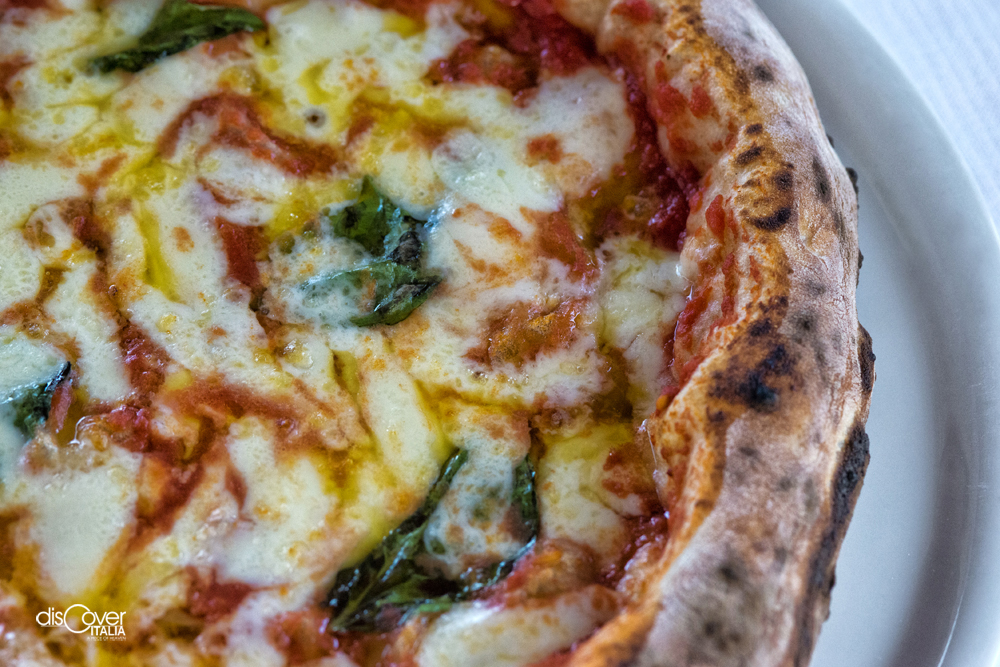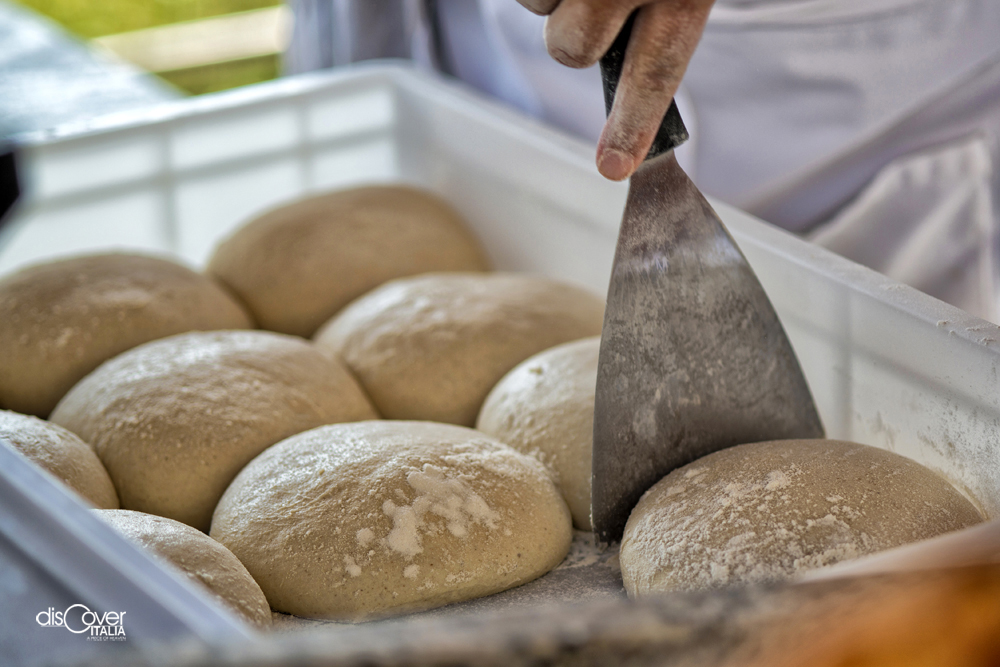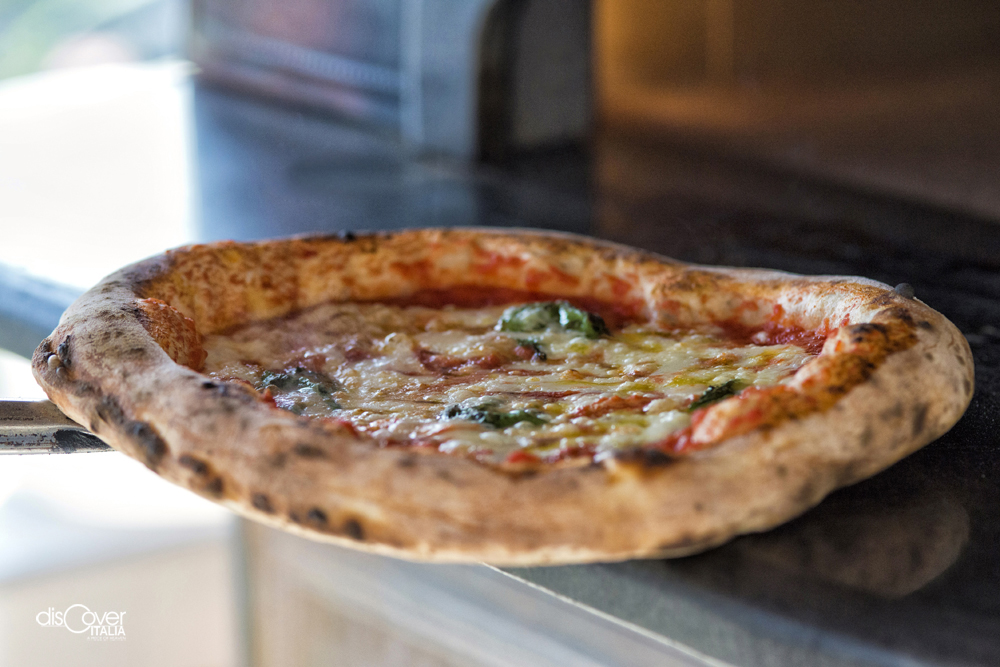
Mastunicola, Marinara or Margherita,
it's always the pizza of Naples
The arrival of tomatoes from Peru at the beginning of the 17th century was an important turning point. A turning point destined to revolutionize the eating habits and the gastronomic traditions also of the Neapolitans, who spent almost a century to make of that fruit, red and flavoured, one of the pillars of their cuisine, especially of the popular. Thus, from the very arrival in the kitchen of the new product, it's possibile to establish a before and an after in the way of cooking and making pizza in the city that conquered on the field the honour of being considered its homeland and that was able to make an excellences of it known all over the world.
 The genesis of the pizza is not precisely Neapolitan in the historical reconstruction. However, it has different elements that can associate it to the city since the most ancient times of its vague origins, because what we call pizza is an evolution of bread. A flattened bread, to be exact, like the one that the Greeks experimented first, who anciently defined it “plakùs ”, which means placenta, an association definitely significant. Subsequently, always in Greece, that kind of bread has taken the name of “pita” and this also is an important element in the story of our favourite flatbread. And Naples was a Greek city, for both its foundation and its culture...
The genesis of the pizza is not precisely Neapolitan in the historical reconstruction. However, it has different elements that can associate it to the city since the most ancient times of its vague origins, because what we call pizza is an evolution of bread. A flattened bread, to be exact, like the one that the Greeks experimented first, who anciently defined it “plakùs ”, which means placenta, an association definitely significant. Subsequently, always in Greece, that kind of bread has taken the name of “pita” and this also is an important element in the story of our favourite flatbread. And Naples was a Greek city, for both its foundation and its culture...
Deeply fond of the city, to the point of making one of its tutelary deities, was also Virgil. In the Aeneid, he described that bread for the first time, used as a dish and eaten after what it contained. It probably was among the consumption of the Italian peoples in the 1st century BC already. Moreover, among the several hypothesis formulated on the etymology of the word “pizza”, one of the most accredited makes it coming from the Latin verb “pinsere”, meaning crush and flatten. In the current version, which has now become a common word in every part of the world, the term “pizza” is officially attributable to the 10th century AD, when it started appearing in contracts written in different cities of central Italy, including Rome. But it will be mentioned in Naples only in the 16th century, which is also the century when a seasoned “schiacciata” (flatbread) appears, used by the people for the simplicity of its ingredients, all very cheap.

They called it mastunicola and it was a sort of focaccia flavoured with lard, garlic and rock salt. Soft and tasty, it filled the belly with just few ingredients. Easily transportable, you could eat it anywhere. Over time, it evolved into a more “refined” version, with olive oil instead of lard, enriched with caciocavallo cheese and flavoured with basil leaves. Strictly white, because tomato was still only American.
If the “mastunicola” was the people’s pizza, for the wealthy classes the term pizza indicated a completely different dish and it continued to be like this for several centuries. In the 16th century the first big collection of recipes was published in six volumes, a precise synthesis of the Renaissance cuisine, by the Popes’ chef Bartolomeo Scappi. Among the thousand recipes, there also are the Royal pie of pigeon pulp also called Lady's lips pizza by the Napolitans and the Pie with different ingredients called pizza. Both were sweet, with sugar and dried fruit, the first one made of short pastry and the second one of puff pastry.
Among the gourmet of that time, pizza continued to identify sweet and salty cakes. Vincenzo Corrado, who was a very famous cook at court and at the cantines of the Neapolitan nobles, but also a man of letters and a philosopher, in his famous The Gallant Cook of 1773 was the first to mention a salty version of the torta alla napoletana (Neapolitan style cake), which between two layers of puff pastry had mozzarella, ricotta, provola cheese, ham, sausage, pancetta, eggs, pepper and cinnamon. That was the “rustic pizza” of the nobles, while the people continued to eat pizzas like the “”mastunicola” and the “cecinielli”, which were small fishes. But in the meantime, the Neapolitan people discovered and appreciated the American novelty: the tomato. And during the 18th century, it became the favourite condiment for maccaroni pasta and for pizza. And in fact, the established origin of the marinara pizza dates back to 1734, with oil, garlic and oregano: it is, in short, the red evolution of the “mastinucola”. Called marinara, because it was the favourite of fishermen and sailor for the ease of transport of the fundamental ingredients. It is in second place among the favourite of the pizza lovers still today.
Nothing to do, however, with the “cultured” version, which was still the only one mentioned in the recipe books in vogue in the 19th century. Even Ferdinand I of Bourbon very much loved the “people” pizza , the one of ‘Ntuono Testa particularly, which he tried, with much resistance from the queen, to introduce to the court receptions. Returning to the official recipe books, in the anonymous “Cucina Casareccia” (home cooking) of 1828, it appears as a stuffed short pastry sweet, while in the 1837 book by Ippolito Cavalcanti, in an appendix in Neapolitan, are described the recipe of a rustic pizza and a sweet pizza with black cherries, blancmange and ricotta. And also made with ricotta was the pizza-pie present in the very famous recipe book by Pellegrino Artusi of 1891.
The first to tell about the pizza "of the streets", which became popular spreading among the alleys in the hearth of Partenope, was Alessandro Dumas father, attentive, passionate observer and narrator of the popular Naples. In "Il Corricolo" of 1843, referring to a trip of 1835, he also wrote about pizza as a flat, round, worked like bread dough, of which he listed the toppings of the various versions: oil, lard, with lard, tomato and small fish. And around 1830, in the book "Naples contours and surroundings" by a certain Riccio, was reported the combination betweeb tomato and mozzarella for the first time: another turning point in the history of pizza.
According to tradition, the tomato and mozzarella version, that became the most famous and requested pizza in the world, dates back to 1889. It was in June when, on the occasion of the visit of King Umberto I of Savoy and Queen Margherita, the best pizzaiolo of that time, Raffaele Espostio, of the pizzeria on the uphill road of Sant’Anna di Palazzo, had the honour of preparing pizza for the sovereigns. He proposed three pizzas: the historic white Mastinucola, the first red Marinara and one with the colours of the Italian flag: the red of the tomato, the white of mozzarella, arranged like the petals of a daisy in honour of the queen, and the green of the basil. The last one struck the Queen, who wrote by her own hand a thank you to Esposito. And the most famous pizza chef decided to call that pizza Margherita. In reality, the mozzarella and tomato pizza already existed, described in the book "Uses and customs of Naples and described and painted outlines", published by the Swiss publisher Francesco de Bourcard in 1853.
Marinara and Margherita are the “Napolitans” par excellence, on the base of which the international regulation of the Associazione Verace Pizza Napoletana was summarized, written in 1984 by Antonio Pace and Lello Surface with the collaboration of the most famous piazza makers of Partenope. The real Neapolitan pizza is circular, with a diameter between 22 and 35 centimeters, with a crust no more than two centimeters high, puffy, soft and golden, without burns. The central part, with a thickness not exceeding a quarter of a centimeter, helds the toppings and the seasoning is made with ingredients preferably from Campania: peeled tomatoes crushed by hand with still evident pieces or fresh cherry tomatoes sliced in wedges ; DOP buffalo mozzarella cut into slices or fior di latte cheese cut into stripes, which must be uniformly distributed; grated cheese that, when used, has to be spread with a uniform rotation movement; fresh basil leaves on the condiments and extra virgin olive oil, poured with the agliara, a copper container with a long and thin spout, to ensure a thin and continuous drizzle of oil, poured in a spiral movement. Strictly cooked in a wood oven, at a temperature between 430 and 480 degrees, for 60/90 seconds, ensuring with specific movements a homogeneous cooking.
From the 5th of February 2010, Neapolitan Pizza is a Traditional Speciality Guaranteed (TSG) by the European Union.
Copyright video, foto e testi © 2020




Comments powered by CComment